Postcards from Montpellier 5 : A Perfect Weekend in Sète
If you're thinking about taking a French course in Montpellier, it's worth knowing the top spots to explore on your weekends—there’s plenty to discover just a short journey away! Read along to find out more about a gem you won’t want to miss: Sète, often called the ‘Venice of Languedoc.’
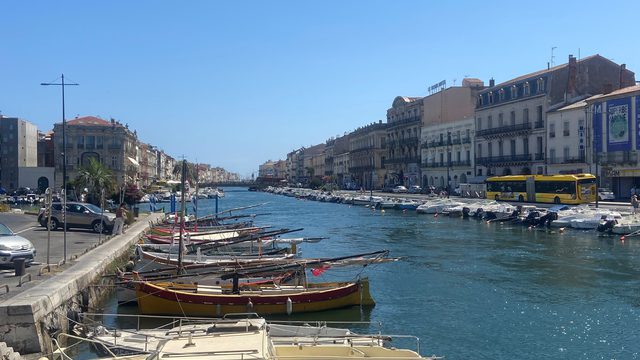
Coucou, welcome back to Postcards from Montpellier! If you’re new here, hi I’m Tallie, currently interning as a receptionist at Institut Linquistique Adenet, one of Wiseward’s partner schools in Montpellier. This internship is part of my year abroad from University as I am a third year, studying French and Spanish. If you love learning languages and discovering new cultures like I do, or if you're just starting out and excited to learn a new language- you're in the right place! At Wiseward, we offer a wide range of language courses tailored to all levels and interests. Why not check out the Wiseward website and see what inspires you?
Now, I may be a little biased, but I genuinely think Montpellier is one of the best cities to learn French in. Having lived here for the last 3 months, I can honestly say I’ve seen real progress in my French- it finally feels like all those years of grammar drills and vocabulary lists are paying off! If you are thinking about signing up to one of the courses at Institut Linguistique Adenet, you’re probably curious about this area of France and the best places to explore during your weekends or free time. Luckily, I have a great place in mind, personally tried and tested
Sète
Often called the ‘Venice of the South of France’ thanks to its charming network if canals, the seaside town of Sète is an absolute must-visit! I’ve been lucky enough to visit twice during my time in Montpellier, and honestly 2 visits just aren’t enough!
Sète makes an ideal weekend getaway, with direct trains getting you there in just 20 minutes. From my experience, this journey felt even shorter- I was distracted by the views of the beautiful French countryside en route.
Despite being a popular spot for tourists, Sète feels like a true escape. The fresh sea breeze, relaxed atmosphere and slow-paced way of life offer a refreshing contrast to city life. On arriving at the train station, you can easily stroll into town down the beautiful Avenue Victor Hugo, a tree-lined street which reminded me of Paris. Within about 10 minutes, you’re greeted by the town’s famous canal, lined with colourful boats, boutiques and restaurants.
Since I’ve fallen in love with this little town, I thought it would be fun to put together a Sète bucket list - perfect for anyone planning a visit!
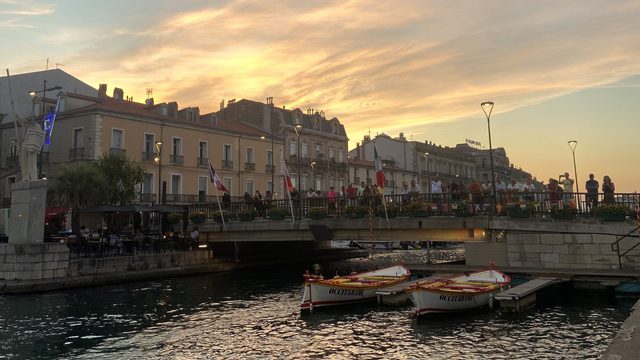
1. Stroll along the Royal Canal with an ice cream.
Try out some of your new French vocabulary and strike up a conversation with a local! Don’t worry if you find it hard to understand them at first- the southern accent in Sète can be quite strong, and some words may sound a bit different. But it’s great practice to hear a variety of accents, and it’ll definitely help improve your listening skills over time.
2. Order seafood at a restaurant on the canal.
For seafood lovers, this is an absolute must!
The town’s unique location between the Mediterranean Sea and the Étang de Thau lagoon makes it a natural hub for incredibly fresh fish, oysters, mussels, and other shellfish. The Étang de Thau is especially famous for its oyster and mussel farms, which produce some of the finest shellfish in France.
During one of my visits I ordered ‘crevettes’ (prawns) to start which tasted fresh out of the sea, followed by a mouth-watering seafood linguine. The food is not only delicious, but the setting is stunning too! Sitting at a table by the canal as the sun sets, a crisp white wine in hand and fresh seafood on the way, what more could you want?!
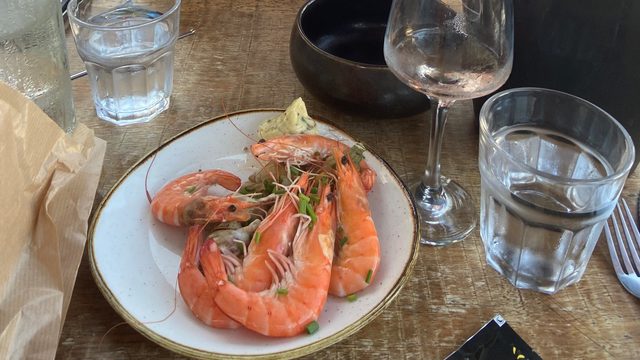
While it's not directly on the canal, a visit to Bouzigues is an absolute must if you're a seafood lover! I recently went with my parents, and I honestly can't recommend it enough. We ate at a lovely spot called L’Oasis du Pêcheur, a family-run restaurant right on the water. As we enjoyed our meal, we had a perfect view of the oyster catchers out on the lagoon. The seafood was, without a doubt, the freshest I’ve ever had- and the warm, welcoming atmosphere made the whole experience even better.
3. Go to the Beach!
There are several beaches in Sète which you can either walk to or take the bus, depending on the distance. Honestly, these beaches are some of the prettiest I have seen on the South Coast of France and the cliffside coastline makes a nice contrast from the long sandy beaches nearer Montpellier. You can take a bus from the town centre and find yourself diving into the refreshing seawater at Plage de La Corniche in just 10 minutes!
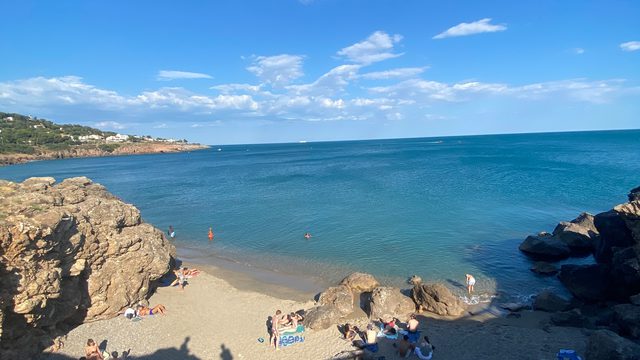
Unlike the beaches in Montpellier, which remain shallow for hundreds of meters, the beaches in Sète become deep just a few meters from the shore. This makes them ideal for snorkelling or even scuba diving. As I lay on the beach, I watched a boat full of eager divers jump into the clear, inviting water. I honestly didn’t realise you could scuba dive just kilometres away from Montpellier! The beaches are definitely worth a visit if you are into water activities and pretty coastlines.
As we’re in the South of France, the beaches here welcome locals and tourists for most of the year. It’s currently September, and the temperature still reaches close to 30°C most days—perfect beach weather, if you ask me!
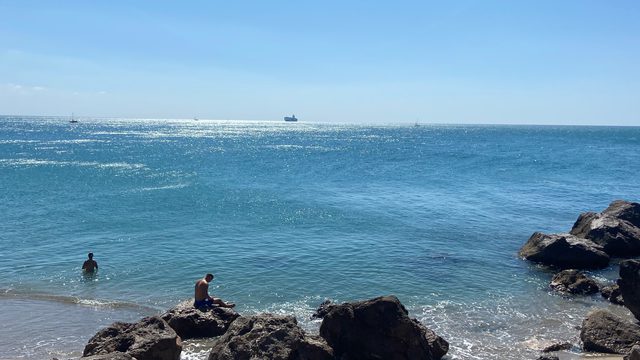
4. Watch the Water Jousting
When talking to my colleagues and host family about going to Sète, they all told me the same thing: watch the water jousting (joutes nautiques)! I, like most other people I assume, was completely alien to this sport. How can one possibly joust on water? Let me try to explain…
The water jousting in Sète is a local tradition which dates back for centuries and is a wonderful blend of sport, spectacle and history. This tradition is said to have begun with the opening of the Port in 1666 and it remains embedded in maritime tradition in the seaside town.
Originally the jousters used to be the fishermen, sailors and dock-workers who spent their lives tied to the sea, however, overtime the sport has developed so that locals can now join in too! In short, water jousting is a duel between two competitors who stand on raised platforms (called tintaine) at the front of their boats. Each competitor holds a lance and a shield (pavois), and the goal is to knock their opponent into the water while keeping their own balance. The boats are rowed by a crew of 10 oarsmen in order to gain enough speed against their opponent boat.
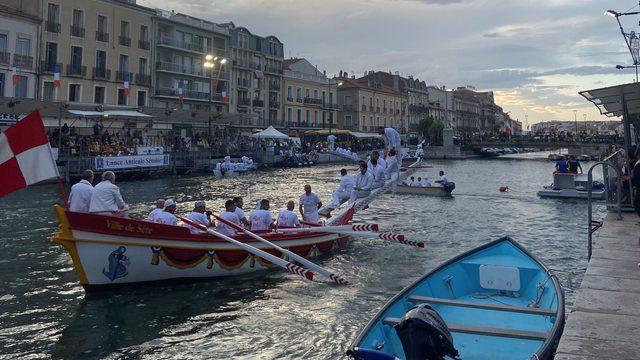
Music also plays an important role in the Sète water jousting: on each boat there is often an oboist or a drummer whose role is to play traditional tunes to set the rowing rhythm and build atmosphere.
The jousting season takes place between June and early September and large groups of spectators line the banks of the Royal Canal to watch. I was lucky enough to watch some water jousting on a trip to Sète and I have never seen an atmosphere like it. I never expected to be so captivated by such a bizarre sport, but I found myself supporting the ‘blue team’ as if I was a local!
5. Take a boat tour
Stepping on board a tour boat is not only a great way to see the sites and learn some facts about the town but also a fantastic way to practice your French outside of the classroom as the tour is in French!
From my experience, there is a wide variety of boat tours in Sète, all of them varying in different lengths and routes. My one piece of advice if you are thinking about doing a boat tour here is make sure you have some cash with you, as none of the places seemed to take card.
A boat tour allows you to further discover the beautiful canals of Sète and, in my opinion, a nice way to feel the sea breeze on your face on a hot day in summer! I chose to do one of the basic boat tours which takes you up and down the canals, through the ferry port and into the open sea to see the fishing farms. It was cool to be able to see where the fish are locally caught and to find out more about the maritime traditions which are embedded in the culture here.
6. Go to the panoramic view
This is the one thing I regret not doing on my visit to Sète…
The Panorama du Mont Saint‑Clair, situated 183m above sea level, gives you sweeping views over the Mediterranean, the beautiful canal network and the unique Etang de Thau. Not to mention the beautiful ancient chapel which sits at the top of the view point. On one side you can see the beaches and the coastline whilst on the other, the oyster catchers are easily spotted. Apparently, on a clear day, you can even see the Pyrenees in the distance!
The panoramic view is easily reachable; it is just a 25 minute walk from the centre of town! Apparently, the best time to visit to this viewpoint is at sunset, whilst the heat of the day is starting to descend, and the amber rays of sun bounce off the Mediterranean below. I am definitely going to visit If I have the time!
Final thoughts:
I hope you have enjoyed reading about the wonderful town of Sète! From beach trips and oyster tastings to watching water jousting tournaments on the Royal Canal. I have fallen in love with this quaint little seaside town and I hope you have too! Sète is the perfect weekend trip if you are looking to explore the Hérault area and experience truly French culture.
If you are interested in expanding your knowledge of French and immersing yourself in a new culture then Wiseward is an excellent place to start or continue your language learning journey! Institut Linguistiaue Adenet, Wiseward’s partner school in Montpellier offers a wide variety of French courses which cater for all levels of French. All courses are bookable through our website.
Thank you for reading and see you soon for more Postcards from Montpellier!
À bientôt,
Tallie💌